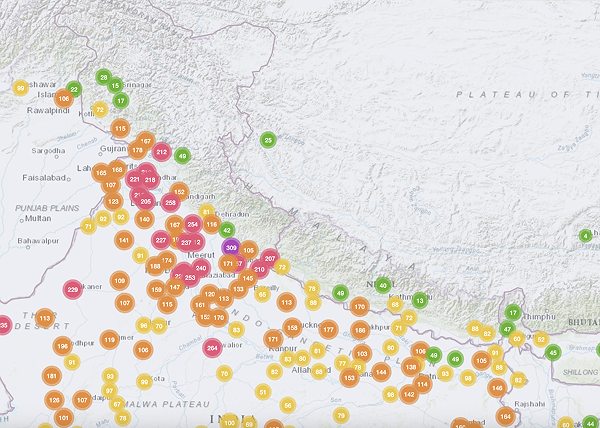Every year as soon as October arrives, Delhi’s air turns dramatically toxic, and people wonder why pollution gets trapped here more than anywhere else.
While stubble burning, traffic and road dust, and industrial emissions add to the problem, the real reason as to why the effect of air pollution is more pronounced lies in Delhi’s geography.
Delhi’s geography and specific meteorological conditions lead to severe air pollution, especially during the post-monsoon months of October- November create a basin-like effect trapping pollutants.
Delhi’s Geography contributing to the air pollution
1. Delhi Sits in the Indo-Gangetic Plain (IGP) – The Basin-like effect

To begin with, Delhi is part of the Indo-Gangetic Plain, a huge flat area stretching across northern India. It is bordered by the Himalayas, the Peninsular Plateau, the Aravalli Hills and the Brahmaputra Valley.
The above Air Quality Index (AQI) Map from AQI.in shows the data throughout the Indo-Gangetic Plan. Clearly, it can be seen that the entire belt consistently experiences poor air quality
Because this land is low and bowl-shaped, air circulation is limited. As a result, polluted air stays close to the ground, especially in colder months when the wind is calm.
2. Surrounded by Natural Walls – Aravalli Hills and Himalayas
Additionally, Delhi is surrounded by natural barriers on two sides.
- In the north, the Himalayas stand tall and stop cold, clean air from flowing in.
- On the southwest side, the Aravalli Hills block wind movement.
As a result, polluted air cannot disperse and has nowhere to escape. This airflow blockage makes Delhi and nearby cities in the belt some of the most polluted regions in the world.
Additional Meteorological Effects on the onset of October Worsening the Situation
1. Pollution Gets Trapped Near the Ground- Urban Heat Island Effect
Moreover, Delhi’s urban surface and buildings add to the problem. The roads, concrete, and vehicles all give off heat, making the air near the ground warmer. This heat creates what scientists call the urban heat island effect.
Consequently, this leads to pollutant formation and them remaining trapped near the ground instead of rising up and dispersing into the atmosphere.
2. Temperature Inversion Blocks Air from Rising
Another major reason is the temperature inversion that happens in October and November. Normally, warm air near the ground rises and carries pollutants upward. But during inversion, the air above becomes warmer than the air below acting like a lid covering the whole capital.
This “lid” traps pollutants below, reducing the vertical mixing height. That’s why smog builds up quickly after sunset during this time of year.
3. Low Wind Speed Makes It Worse
Additionally, wind speed drops during late October and early winter. With slower winds, pollution does not spread out or move away from the city. Instead, it stays suspended over Delhi for days, mixing with moisture and forming thick smog. This is also when smoke from stubble burning in nearby states drifts in and adds to the problem.
Delhi: A Six-Dimensional Pollution Trap

Delhi, thus, sits inside a 6-dimensional natural trap that locks in pollution from all sides:
- North – The Himalayas block airflow.
- Southwest – The Aravalli Hills stop wind movement.
- East & West – Surrounded by the flat Indo-Gangetic Plain that holds pollutants.
- Below – Urban heat and hard terrain trap air near the ground.
- Above – Temperature inversion in October–November creates a lid.
- All Around – Low wind speeds prevent dispersion.
All in all, these six factors make Delhi a bowl where pollution accumulates and persists, especially during winter months.
Conclusion
To sum up, Delhi’s air pollution problem is not only man-made but it’s also caused by where the city is located. Being in a basin-shaped plain, surrounded by hills, and facing slow winds with temperature inversion, Delhi becomes a natural pollution trap every winter.
Understanding how geography affects pollution helps experts create better air quality forecasts and early warning systems so we can all breathe with a little ease in the future